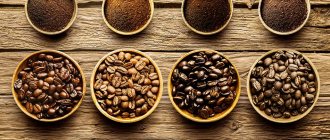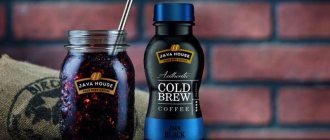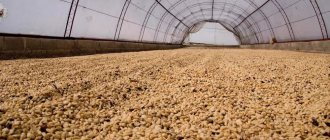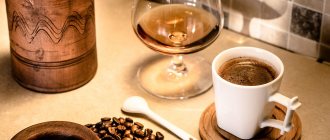Listing all the types and names of coffee is not an easy task: many drinks are prepared from coffee beans, and many peoples have their own traditional recipes.
Some brewing methods have been known for a long time in Eastern and African countries. A significant part of the recipes owes its origin to Italy, the trendsetter of coffee fashion.
Coffee-based drinks differ in additional ingredients, their proportions and mixing methods. In some, strong and aromatic espresso plays the leading role, in others, which are milder in taste, milk predominates. Coffee fans know the difference between a latte and a cappuccino and espresso, and a doppio from a lungo. And novice gourmets need to get acquainted with the basic cooking options so as not to get confused when studying the menu in a coffee shop.
What it is
What is coffee itself? This is a genus of shrubs, the size of our lilac. True, it grows smaller in the apartment, about the size of a fattened potato bush.
Outside plantations it grows in Africa and, partly, Asia. According to legend, the invigorating properties were first noticed by the Ethiopians in 850. But, naturally, every country wants to get its hands on the legend of the discovery of coffee, so it’s better to keep silent about the Ethiopians in Brazil and most African countries. The genus “coffee” is great, but what are we drinking?
Kinds
In fact, there are almost 100 known species of this tree. But the 3-5 most popular ones end up on our table.
Arabica
Who doesn't know Arabica? This species is the most popular, accounting for more than 60% of all plantations. The reason for this was purely taste. Arabica is an artificial species obtained by mixing two natural ones.
The taste is rich, the expensive type has notes of the place where it was collected: citruses, chocolate and others. The drink is moderately bitter, moderately sweet, but always rich and unique. This is a mass product because most people like it.
But Arabica is extremely whimsical. It grows only at a certain height, is susceptible to parasites, diseases and can come up with 100 more reasons why the planter will not make his profit this year. That's why she's expensive.
Robusta
One of the progenitors of Arabica. The plant is unpretentious: it grows wherever it is warm. Parasites do not like her, diseases do not take her. It is cheaper than Arabica because it is cheaper to grow and yields more abundantly. So why isn't she at the top?
It's all a matter of taste. Robusta has no aftertaste at all, it is more bitter, and the taste is called “flat”. But it is still grown, approximately 30% of all plantations.
The reason for the popularity of Robusta is its price. Many industries need cheap coffee, even in many coffee shops they use a mixture of Arabica and Robusta to reduce the cost of raw materials (but they may tell you that it is to give strength, because Robusta is stronger. Believe it or not, it’s up to you.
Liberica
I'm already delving into the specifics. But what if you've heard of her?
This bush is small, the fruits on it are few and smaller than those of Arabica. It is rarely used because of its unpleasant taste, either in cheap coffee or in blends. If you come across the label “Liberica”, this is the lowest variety among the masses.
There are many varieties, but for mass production Arabica and Robusta are mainly used, the rest is in poor countries or in places for exotic lovers.
Types of coffee and their composition
Bean quality level
The quality of a ready-to-drink coffee drink is marked in accordance with the international classification:
- A, AA - elite varieties of the highest quality;
- AB - good quality and excellent taste;
- B, BA - budget grade of average quality;
- BB, C - low quality variety.
Geographical location of the plantation
Relief, climate and other characteristics are important for each type of coffee even during the growing process. For Arabica, an altitude of 700-800 meters above sea level is required, for Robusta - up to 500-800. The geographical origin of coffee is also marked:
- CS - grown on low plains;
- HG - grown in the foothills;
- SHG - grown in mountainous areas.
Processing method
The most popular types of coffee differ in the processing method, of which two are usually used:
- Natural (dry). The berries are dried naturally - laid out on the patio and kept in the sun until the skin peels, or special drying machines are used.
- Washed. In regions with high humidity, grains are not dried, but the gluten is washed out through fermentation, and then dried.
The dry processing method allows you to preserve a richer and softer taste.
Roasting degree
Roasting is necessary so that essential oils are released from the coffee, caramelization occurs and the drink acquires pleasant notes in taste. There are 5 types of coffee according to the degree of roasting:
- Light. Roasted at a temperature of 195-210 degrees, the grains receive a light brown tint, a dry surface and a sour taste.
- Average. Roasting occurs at a temperature of 210-220 degrees. The grains become rich light brown or brown with a matte surface. The taste mixes sour, sweet and bitter notes.
- Medium-dark. For frying, a temperature of 230-240 degrees is required. The grains have a slightly glossy surface from essential oils and a pronounced brown tint. The taste combines sweetness and bitterness with a slight sourness.
- Dark. Fry at a temperature of 240-250 degrees. The coffee beans are oily and dark brown in color. They have a bittersweet aftertaste, with virtually no sourness.
- Very dark. Roasting is performed at a temperature of 250 degrees. The coffee has a very dark, almost black hue, a rich bitter taste with a sweet aftertaste and no sourness at all.
Grinding type
The taste of the drink and the types of coffee preparation largely depend on the grind:
- Small. The grains are ground for 12-15 seconds. Suitable for Turkish.
- Average. Grinding time is 10-12 seconds. Suitable for carob coffee maker, coffee machine.
- Large. The coffee is ground for 7-10 seconds. Suitable for French press or drip coffee maker.
Varieties
The smallest section. I just want to say that there are a lot of varieties, sort of subspecies. Each planter receives his own subspecies of Arabica, often more than one. This is why a gourmet will distinguish Brazilian coffee from Vietnamese. And some even have favorite manufacturers.
Admit it, do you have a favorite brand that you would never change?
How grains are processed
The grains have been collected from the tree, what next? We have two ways: the first one you know and have seen a hundred times, and the second one is for true gourmets.
Classic processing
Let's start by picking the fruits and removing the pulp from them. The pulp also contains caffeine, but coffee is not brewed from it. There are several ways. In dry processing, the pulp is dried and then removed by machine.
If wet, soak and remove. Then the seeds are peeled and the green coffee is sent to other countries. Roasting occurs shortly before being sent to the pack and then to the store.
Animal assisted processing
Kopi Luwak. For connoisseurs of the unusual, one of the most expensive. The marten living in Malaysia is given coffee berries. Musang, that’s the name of the animal, eats them with pleasure. And the grains come out naturally. They are washed, fried and sold to tourists. This coffee is considered one of the most delicious among ordinary people and very mediocre among tasters.
There are several other methods of biological processing, but it’s time to talk about lattes.
Cooking methods
A pack of coffee is on your table. What can you do with it? For starters, there are hundreds of brewing methods.
Pressure brewing
All possible presses, coffee machines familiar to us. The idea is that water is forced through the coffee under pressure, which has a beneficial effect on the taste. But manually, without special devices, nothing will work, alas.
Here are the basic machines for simple cooking:
- Espresso machine.
- Moka
- Aeropress.
Soak
The classic representative is the French press and its analogues.
The most common home appliance. Good taste with ease and speed of brewing and easy maintenance of the jug.
Drip brewing
The American version, remember from the movies or have you seen it yourself? Place the filter, coffee on it, boiling water on top and wait for it to filter.
The drink turns out weak, especially if you grind it too coarsely, but it’s quick and convenient. Especially for mass events, when quantity is more important than quality.
- Percolator. Here the coffee, on the contrary, is too bitter and strong.
- Kalita.
- Vietnamese filter.
Of course, there are other options, but the article is not rubber-stamp.
Boiling
The most historical option. And its simplest execution is cowboy. Pour boiling water over the coffee and let it brew for about 5 minutes until the sediment settles. And here is the coffee that your ancestors drank.
Coffee in Turk, or Turkish. How to cook it in a Turk is a separate science, still based on trial, error and the search for your own taste.
These are the cooking methods I found for you. There is no exotic stuff here, but I tried to collect all the basics. And there you have it, coffee in your cup, jug or turk. What's next?
What blends deserve the title of the strongest coffee?
In addition to single varieties, in the world of coffee there are many blends that are sold in ready-made form.
Which mixtures deserve the title of the strongest?
- Death Wish . Translated as "Dying Wish". It has a caffeine content 1.5 times higher than the strongest espresso. You can buy it at the coffee shop of the same name, which is located in New York, or through online stores. The composition of this mixture is kept strictly secret, but it is considered the strongest in the world.
What can you buy in our coffee shops and stores to cheer you up in the morning?
- Paganini . An espresso blend containing about a quarter of strong robusta. These grains make a thick, rich and invigorating drink. It is considered one of the strongest mixtures.
- Espresso IR . It contains very dark, so-called Italian roasted beans. The finished drink is dark in color, high in caffeine and has a characteristic nutty aroma. This mixture can be found on sale under the name “Italian espresso”.
On supermarket shelves
It is not always possible to get to a specialized coffee store. On supermarket shelves you can also choose the strongest coffee option.
- Blaser Opera . The composition contains Javanese robusta, the strength is enhanced by dark roasting of the grain. An excellent option for a morning espresso or a cup of oriental coffee.
- Blaser Rosso & Nero . It also contains a mix of Arabica and washed Robusta. In addition to the high caffeine content, the taste of this mixture is perceived as particularly strong, thanks to pronounced notes of nuts and dark chocolate.
- Lavazza Grande Ristorazione . A blend with more Robusta than Arabica. Quite strong, albeit harsh taste. Ideal for espresso machines, not so good in a cezve.
- Sumatra Mandheling from Jardin is a single variety that is distinguished by both strength and richness. It can be used to make espresso, but even in a regular Turkish coffee it shows decent results with a high caffeine content.
- Espresso Di Milano Style . A strong blend that invigorates well. Strong roasting of the grain enhances the feeling of strength of the finished drink.
Cooking methods
We have brought our seed to the moment that you have all been waiting for so long. What kind of coffee is served in a cup?
Let's talk about the fact that you brewed espresso by default. This is approximately 50 ml.
Espresso
Take and drink your coffee. Many people drink this drink without extra water and especially milk. Only coffee and nothing else. Ideal to wake up before the work day.
Ristretto
This is a very robust species. In cafes they serve it with water. This is espresso without half the water. In a coffee machine, you press the espresso and remove your cup halfway through the process. To prepare it by hand, you will have to try several recipes and find yours.
This drink will invigorate you even after a sleepless night.
Americano
In Turk you most likely cooked Americano. This is espresso that you pour into a 300 ml mug and top up with hot water or hot milk. The most common coffee to order in cafes.
It's not too strong, not too watery. At the same time there is a lot of it. An ideal combination for many occasions.
Cappuccino
Do you think that an Americano with milk is already a cappuccino? Oh no, making a proper cappuccino at home will be difficult unless you have a special whisk.
When making a cappuccino, you pour your espresso into a cup, for example, for tea. Next, you whip the milk into a thick, elastic foam. Such that its surface is glossy. And put this foam in a cup. Is the gloss still there? Are there any large bubbles on the surface? Congratulations, you have the perfect cappuccino.
The milky taste appears when standing, when the heat of the coffee transfers part of the milk to it. Ideally, you eat the foam separately and drink the coffee afterwards.
Latte
An option for those with a sweet tooth. First, pour milk into a glass, then carefully pour coffee along the side and finally syrup. What do you get?
The latte needs to be layered, otherwise you've done it wrong. Layering is needed to convey the flavors of all three components - first you drink soft foam, then bitter coffee, milk and finally sweet syrup. Or, vice versa, if you like it with a straw.
Mocha
Latte with chocolate
Raf
Coffee, cream and vanilla syrup. For lovers of sweets and those who do not like bitterness.
Glasse
Americano and a scoop of ice cream on top. Sweetness and milk from the ice cream, bitterness and warmth from the coffee.
Coffee cocktails
Need I say that there are classic options like frappe, and then there are the ideas of hundreds of baristas around the world?
Who is advised to consume the drink?
The delicate drink not only contains a pleasant creamy taste, but is also an alternative to grain coffee. Who may need the recipes listed above:
- People wishing to reduce their daily caffeine intake. This substance decreases when milk foam is added to the drink. Its effect on the body will be more gentle.
- For some chronic diseases, it is strictly not recommended to drink strong coffee. A drink with milk will be an alternative solution.
- The drink diluted with warm milk can be drunk in childhood. Caffeine-containing products are contraindicated for children. Milk will reduce the effect of caffeine on the child's body.
If you are following a low-calorie diet, you should add 1% milk to your coffee drink. Girls who are watching their figure are not recommended to drink high-calorie macchiatos and lattes. Due to the large amount of milk, each serving of the treat contains at least 100 kcal.











